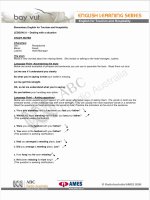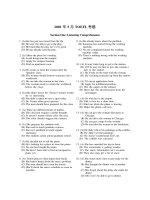Lesson 21- Power Station Automation
Bạn đang xem bản rút gọn của tài liệu. Xem và tải ngay bản đầy đủ của tài liệu tại đây (127.57 KB, 4 trang )
Lesson 21- Power Station Automation
With regard to the functions of the power station automation, people may fill up a
long list as follows:
(1)The automatic starting of generating sets.
(2) The automatic switching on after electrical voltage is established.
(3)The automatic adjustment of electrical voltage.
(4) The automatic unloading by different stages of secondary electrical users when
generators are overloaded.
(5)The automatic parallel of generators.
(6) The automatic regulation of frequency and load of generators after their being
paralleled.
(7) The automatic load transfer before a generator is out of service.
(8)The automatic switching off in the case of generator failure.
Nowadays, first priority has been given to an A. C. power station for common
vessels, and the generators of self excitation and constant voltage are widely adopted. By
the self excitation, it means that the excitation needed will be supplied by a generator
itself when it is in operation. By the constant voltage, it is meant that a generator is
equipped with a compound excitation device, which is capable of compensating the
voltage fluctuation and thus keeping the voltage within the allowance when the generator
voltage fluctuates due to load changes.
Generators may be overloaded in service owing to the increase of additional
loads. In order to ensure the continuity of power supply and protect the generators from
overloading, it is necessary to unload some of the electrical users. These years, the
automatic unloading device for the marine power station is either of transistor loop or
composed of relay contactor, which automatically unloads some secondary electrical
users by different stages and ensures the continuous power supply of the other primary
electrical users.
In case a marine power station is armed with two or more generators, it is
frequently required to run them in parallel so as to obtain the continuity and economy of
power supply. In respect to A. C. generators, it is allowed for them to be paralleled and
switched on only when they possess the same voltage, frequency, phase sequence and
phase angle. And the above-mentioned operation is to be performed either by hand
control or through an automatic accurate synchro device. The present-day accurate
synchro device in use takes a transistor loop, which consists principally of frequency
regulation, frequency difference latching, voltage latching, switching on and power
supply.
To ensure the quality of power supply and the reliability of generator operation, it is
required to maintain the constant frequency of the network and achieve a uniform load
distribution between the generators in parallel. In the old days, this was done by an
electrician on duty. But with the development of the power station automation, the
automatic frequency-adjusting and load-adjusting devices have come into use, which
generally consist of frequency convertor, power convertor and regulator and so on. The
function of the above two convertors is to convert both the frequency signals of the
power station and the power signals of the generating set into the D. C. signals that will
be input into an impulse-type regulator. And the regulator will shed the speed-regulating
impulses in accordance with the magnitude of the input D. C. signals, and contact the
servo motor by means of a silicon controlled rectifier(SCR) to alter the speed of diesel
engines so that a uniform load distribution between generators and the rated frequency
are thus maintained.
New Words and Expressions
1. unload v.giỡ tải,cắt tải
2. overload v .quá tải
3. parallel n mắc song song
4. load transfer truyền tải
5. self excitation tự kích hoạt
6. constant voltage điện áp không đổi
7. excitation n .kích hoạt
8. compound excitation kích hoạt phức
9. fluctuation n.biến động,ba động
10. allowance n .hạn định cho phép
11. fluctuate v.dao dộng
12. transistor loop mạch vòng bán dẫn
13. phase sequence trình tự pha
14. phase angle góc pha
15. accurate synchro device thiết bộ đồng bộ chính xác
16. frequency regulation việc điều hành tần số
17. frequency difference latching việc toả định (khoá) độ chênh tần số
18. voltage latching khoá điện áp
19. uniform a. đổng bộ
20. load distribution phân bố tải trọng
21. electrician n .thợ điện
22. convertor n bộ chuyển đổi
23. regulator n. bộ điều chỉnh
24. input v . n .nhập vào
25. impulse-type a .kiểu xung
26. shed v .tung ra
27. contact v .tiếp xúc
28. silicon controlled rectifier(SCR) bộ chỉnh điều khiển bằng silicon
29. the rated frequency tần số danh định
30. thyristor n thyristor
Verb Phrases and Collocations
1. fill up lấp đầy bảng
2. switch on đóng mạch
3. secondary electrical user hộ dùng điện thứ hai
4. be out of service ngừng
5. switch off cắt mạch
6. give first priority to ưu tiên số một
7. primary electrical user hộ dùng điện thứ nhất
8. in parallel mắc song song
9. in the old days trước đây
10. on duty trực,đang làm nhiệm vụ
BÀI 21-TỰ ĐỘNG HOÁ TRẠM MÁY PHÁT ĐIỆN
Xét về chức năng tự động hoá trạm điện ,người ta có thể nêu ra một bảng dài như
sau:
(1) tự động khởi động máy phát
(2) tự động đóng mạch khi điện áp đã ổn định
(3)tự động điều chỉnh điện áp
(4)tự động dỡ tải ở các giai đoạn khác nhau của hộ dủng điện loại hai khi máy
phát quá tải
(5) tự động đấu song song các máy phát
(6)tự động điều chỉnh tần số và tải của các máy phát khi các máy được đấu song
song.
(7)tự động chuyển tải khi một máy phát ngừng hoạt động
(8)tự động cắt mạch khi máy phát có trục trặc.
Hiện nay,ưu tiên hàng đầu là cho trạm phát AC trên các tàu thông thường và máy
phát tự kích có điện áp không đổi là loại được dùng rộng rãi.Với loại tự kích hoạt ,có
nghĩa là việc thực hiện kích hoạt cần thiết được thực hiện bởi chính máy phát khi nó đi
vào hoạt động.với điện áp không đổi có nghĩa là máy phát trang bị thiết bị kích phức ,có
thể bù trừ những dao động điện áp và như vậy giữ cho điện áp nằm trong phạm vi cho
phép khi điện áp của máy phát dao động do tải thay đổi.Máy phát có thể quá tải trong sử
dụng do tăng các tải trọng phụ.Để bảo đảm cấp điện được liên tục và bảo vệ máy phát
khỏi quá tải ,cần phải cắt một số hộ dủng điện.Hiện nay,thiết bị tự động cắt tải cho trạm
điện trên tàu thì thường hoặc dùng mạch vòng transistor hay tổ hợp các rơle côngtắc,thiết
bị này tự động cắt tải các hộ dùng điện loại hai vào các giai đoạn khác nhau và đảm bảo
liên tục cấp điện cho các hộ dùng điện loại một.Trong trường hợp trạm điện trên tàu trang
bị hai hay nhiều máy phát,thường phải mắc chúng dong song với nhau để đảm bảo việc
cấp điện được liên tục và tiết kiệm.Đối với các máy phát AC ,chỉ cho phép chúng mắc
song song và đóng mạch khi chúng có cùng một điện áp ,tần số,trình tự pha và góc
pha.Và việc thao tác nói trên phải được thực hiện hoặc bằng điều khiển thủ công hoặc
thông qua một thiết bị synchro tự động chính xác.Thiết bị synchro chính xác hiện nay
thường dùng một mạch vòng transistor ,nó chủ yếu gồm cái điều chỉnh tần số,bộ khoá
hiệu tần số ,bộ khoá điện áp,bộ đóng mạch và bộ cấp điện.để đảm bảo chất lượng việc
cấp điện và độ tin cậy trong khi thao tác máy phát,cần phải duy trì tần số không đổi của
mạng lưới và phân bố tải đồng đều giữa các máy phát mắc song song .Trước đây việc này
thực hiện bởi một kỹ thuật điện trực.Nhưng với sự phát triển của việc tự động hoá trạm
điện,các thiết bị tự động điều tần và điều áp đã được đưa vào sử dụng ,nói chung nó gồm
có cái chuyển đổi tần số,cái chuyển đổi công suất,cái điều chỉnh vân vân,Nhiệm vụ của
hai cái chuyển đổi nói trên là chuyển đổi cả hai tín hiệu tần số của trạm và tín hiệu công
suất của máy phát thành các tín hiệu DC ,tín hiệu này được nhập vào một cái điều chỉnh
kiểu xung..Và cái điều chỉnh này sẽ tung ra các xung điều khiển tốc độ căn cứ theo biên
độ của các tín hiệu DC nhập vào,và tiếp xúc với động cơ servo thông qua một bộ tinh
chỉnh điều khiển silicon SCR để thay đổi tốc độ của động cơ diesel sao cho duy trì được
sự phân bố đồng đều tải trọng giữa các máy phát và tần số đã định.









